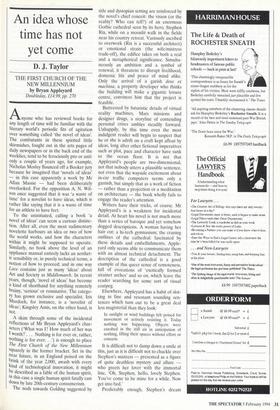An idea whose time has not yet come
D. J. Taylor
THE FIRST CHURCH OF THE NEW MILLENNIUM by Bryan Appleyard Doubleday, £14.99, pp. 270 Anyone who has reviewed books for any length of time will be familiar with the literary world's periodic fits of agitation over something called 'the novel of ideas'. The combatants in these spirited little skirmishes, fought out in the arts pages of daily newspapers or in the back end of the weeklies, tend to be ferociously pro or anti: only a couple of years ago, for example, Nicholas Mosley flounced off a Booker jury because he imagined that 'novels of ideas' — in this case apparently a work by Mr Allan Massie — had been deliberately overlooked. For the opposition A. N. Wil- son once suggested that it was 'a waste of time' for a novelist to have ideas, which is rather like saying that it is a waste of time for an athlete to have feet.
To the uninitiated, calling a book 'a novel of ideas' can seem a curious distinc- tion. After all, even the most rudimentary novelette harbours an idea or two of how the world works, and how the characters within it might be supposed to operate. Similarly, no book above the level of an appliance manual entirely lacks an aesthet- ic sensibility or, in purely technical terms, a notion of how to proceed; and in one way Lace contains just as many 'ideas' about Art and Society as Middlemarch. In recent years, though, 'novel of ideas' has become a kind of shorthand for anything remotely brainy, 'serious' or ruminative. The catego- ry has grown exclusive and specialist. Iris Murdoch, for instance, is a 'novelist of ideas'; Kingsley Amis, on the other hand, is not.
A skim through some of the incidental reflections of Mr Bryan Appleyard's char- acters ('What was I? How much of her was I worth? . .. Nothing is for ever or, rather, nothing is for ever. . .') is enough to place The First Church of the New Millennium squarely in the former bracket. Set in the near future, in an England poised on the brink of the year 2,000, awash with every kind of technological innovation, it might be described as a fable of the human spirit, in this case a single human spirit fatally cast down by late 20th-century consumerism. The nods towards Golding suggested by title and dystopian setting are reinforced by the novel's chief conceit: the vision (or the reality? Who can tell?) of an enormous Gothic cathedral seen by its hero, Stephen Rix, while on a moonlit walk in the fields near his country retreat. Variously ascribed to overwork (Rix is a successful architect) or emotional strain (the wife/mistress trade-off), the edifice takes on both a real and a metaphorical significance. Simulta- neously an ambition and a symbol of renewal, it threatens to disrupt livelihood, domestic life and peace of mind alike.
Only the arrival of a garish deus ex machina, a property developer who thinks
the building will make a gigantic leisure centre, convinces him that the project is feasible.
Buttressed by futuristic details of virtual reality machines, Mars missions and designer drugs, a storyline of contending personal crises ambles steadily forward. Unhappily, by this time even the most indulgent reader will begin to suspect that he or she is adrift on a craft kept afloat by ideas, long after other fictional imperatives such as plot, pace and character have sunk to the ocean floor. It is not that Appleyard's people are two-dimensional, not that nobody utters a plausible sentence, not even that the wayside excitement about in-car traffic computers seems only a garnish, but simply that as a work of fiction — rather than a projection or a meditation on architecture — the book wholly fails to engage the reader's attention.
Writers have their tricks, of course. Mr Appleyard's is a weakness for incidental detail. At heart his novel is not much more than a series of baroque and yet somehow dogged descriptions. A woman having her hair cut; a hi-tech gymnasium; the craning outlines of the cathedral: fascinated by these details and embellishments, Apple- yard only seems able to communicate them with an almost technical detachment. The description of the cathedral is a good example of this queer sense of remoteness, full of evocations of 'exotically formed strainer arches' and so on, which leave the reader searching for some sort of visual coatpeg.
Elsewhere, Appleyard has a habit of slot- ting in fine and resonant sounding sen- tences which turn out to be a great deal less magisterial than they look:
In sunlight or wind buildings felt poised for movement or actively resisting it. Today nothing was happening. Objects were enrobed in the still air in anticipation of nothing, filling their spaces without effort or concern.
It is difficult not to damp down a smile at this, just as it is difficult not to chuckle over Stephen's mistress — presented as a figure of quite deathless mystery and allure who greets her lover with the immortal line, 'Oh, Stephen, hello, lovely Stephen. You've come to be mine for a while. Now get into bed.'
Predictably enough, Stephen's dream
turns sour, and the ending is a relentless demolition — literally — of once exultant hope. None of this, though, is sufficient to redeem the earlier longueurs. The First Church of the New Millennium contains some amusing prophecy and some good jokes — among other things it is a sort of unintentional exposé of the architectural profession — but as a novel, like Stephen's cathedral, it scarcely begins to exist.
D. J. Taylor's latest book, After the War: The Novel and England since 1945, is pub- lished by Chatto at £17.99.



















































 Previous page
Previous page